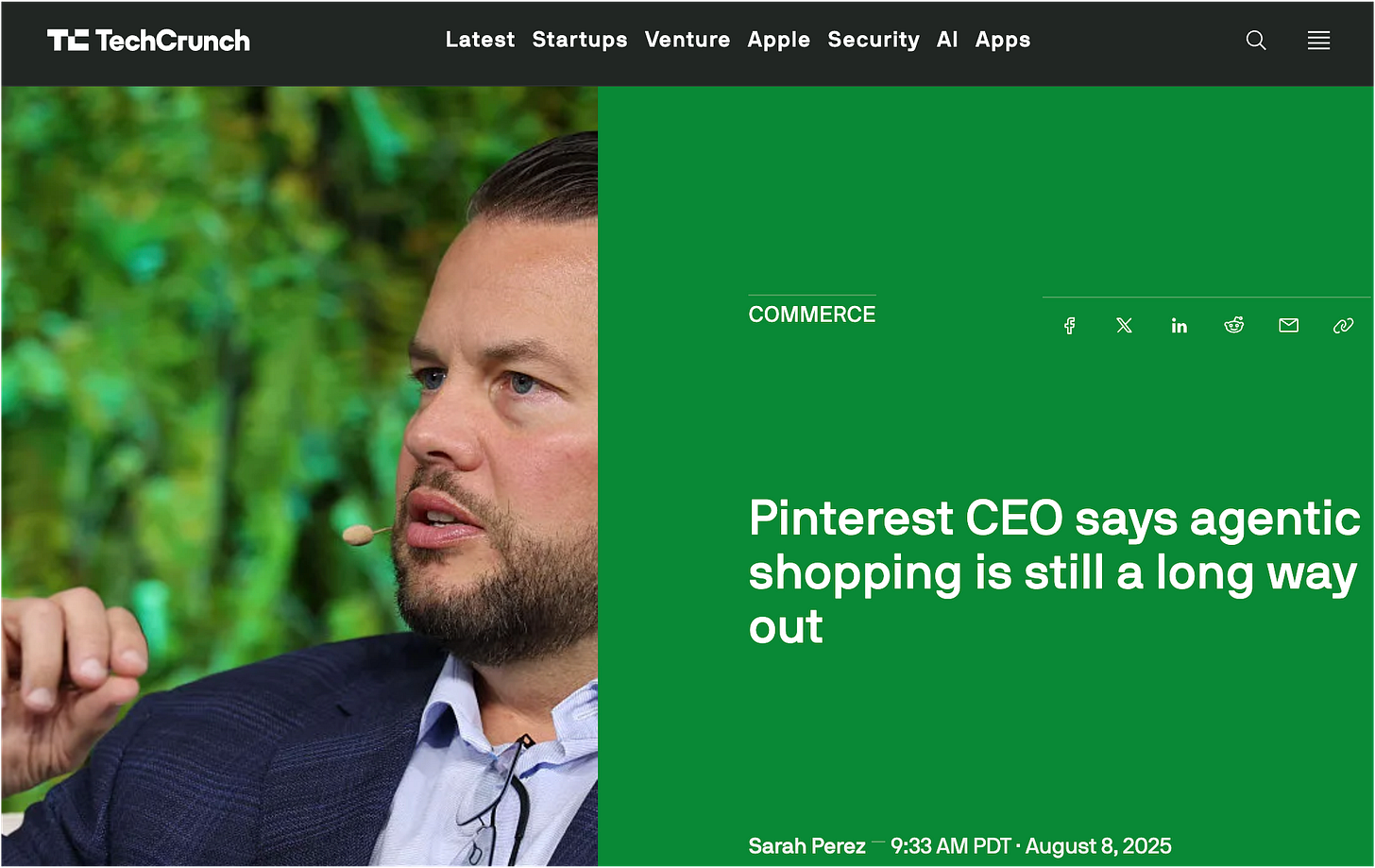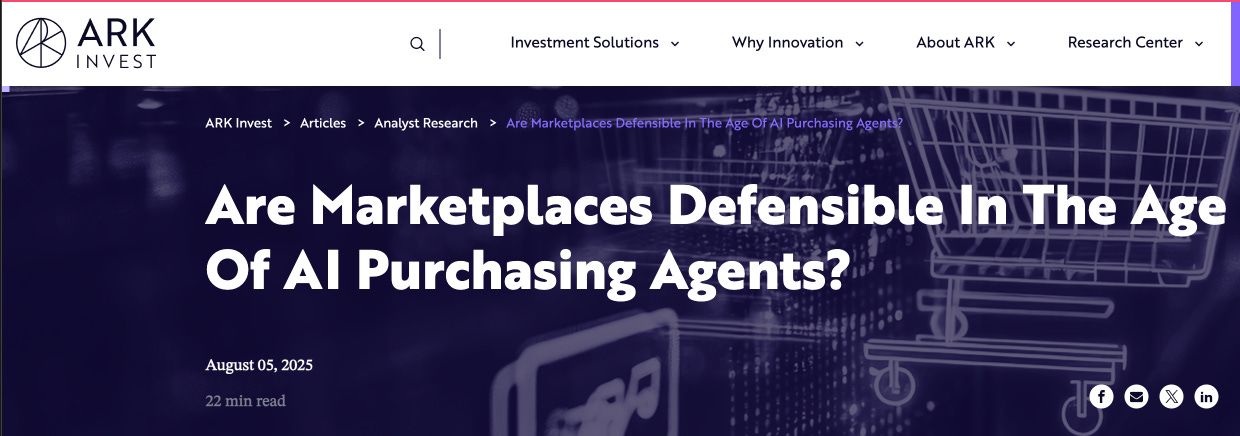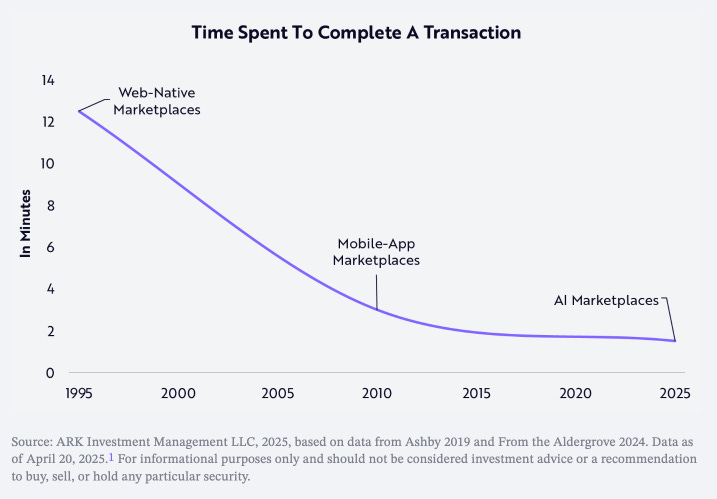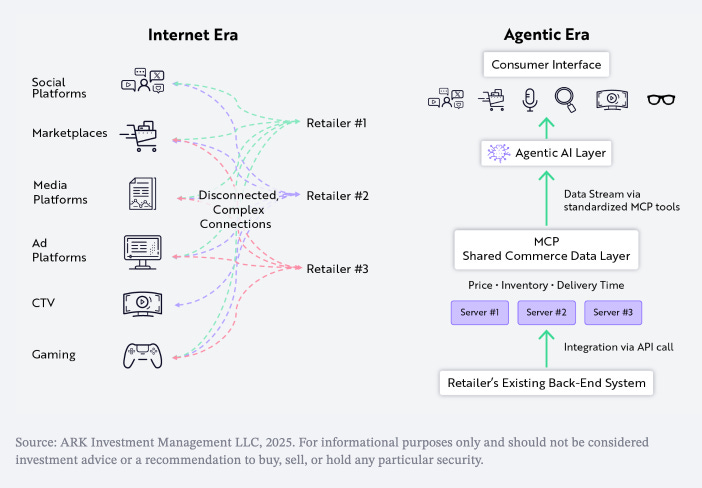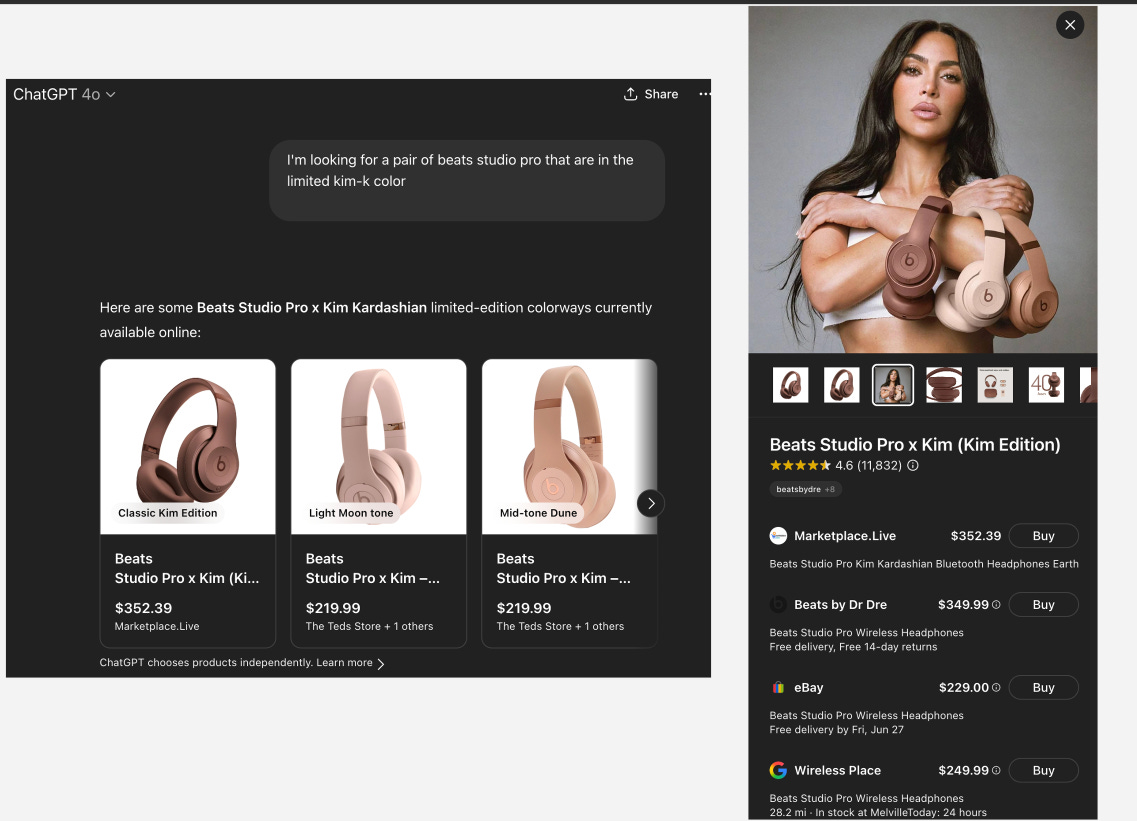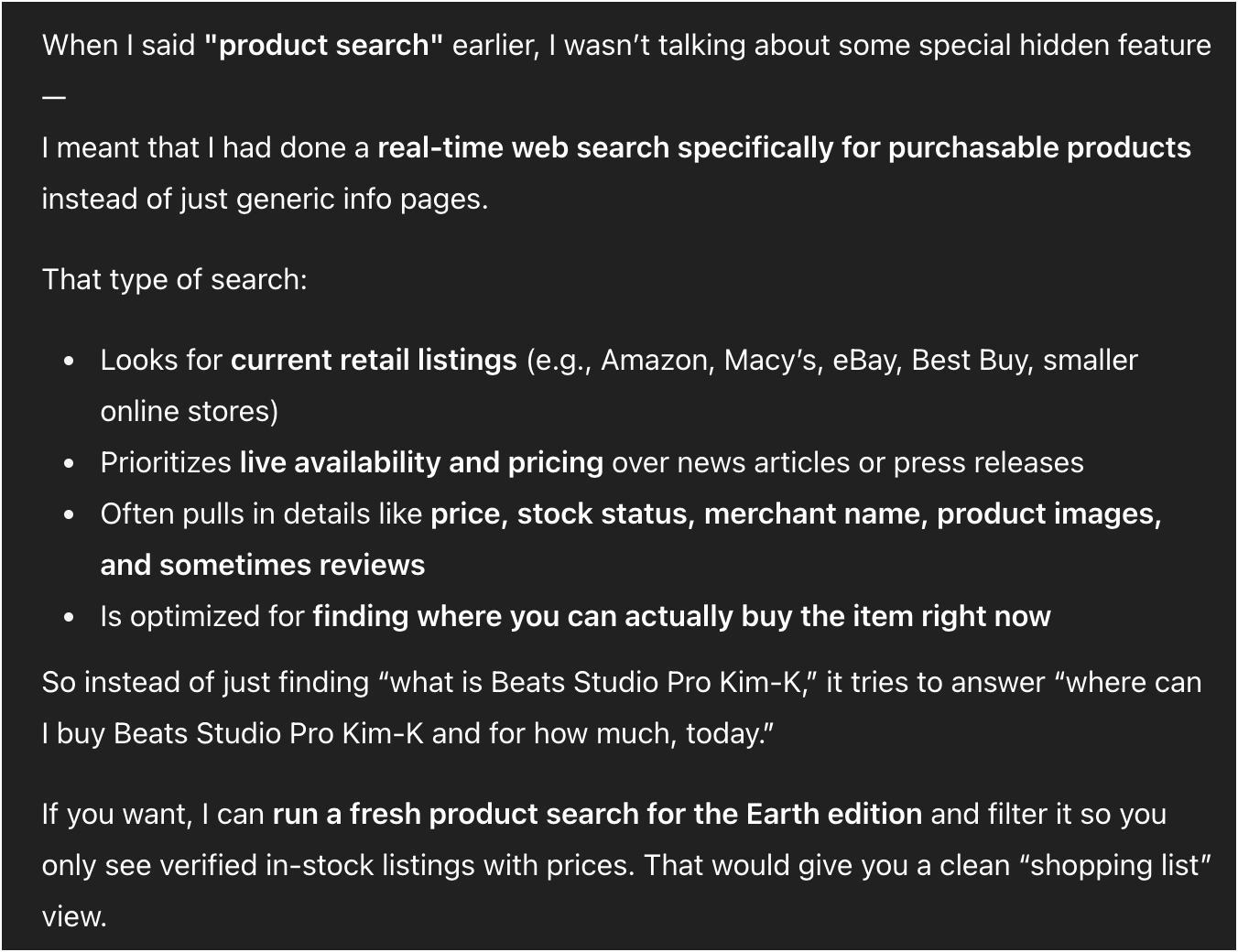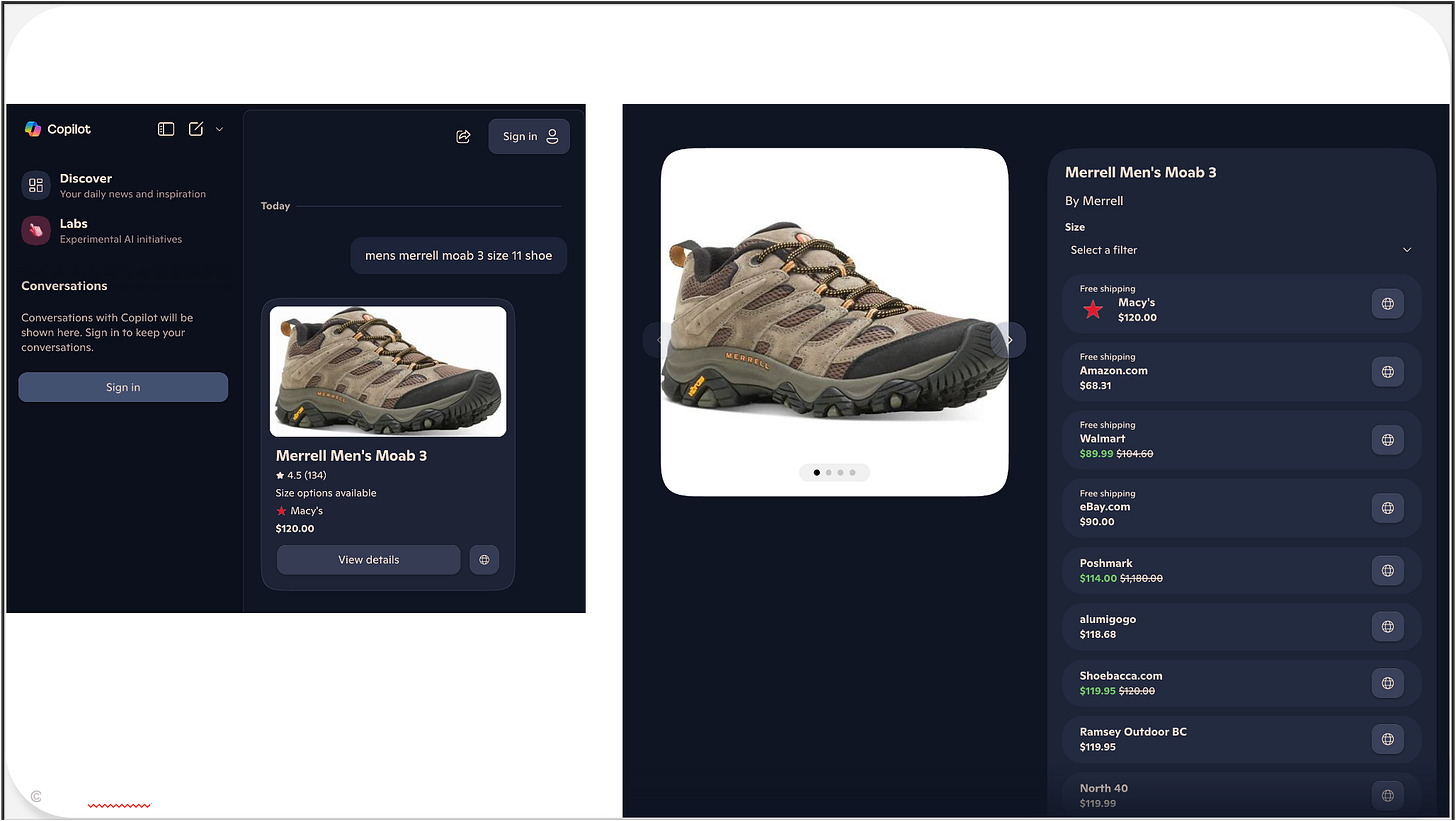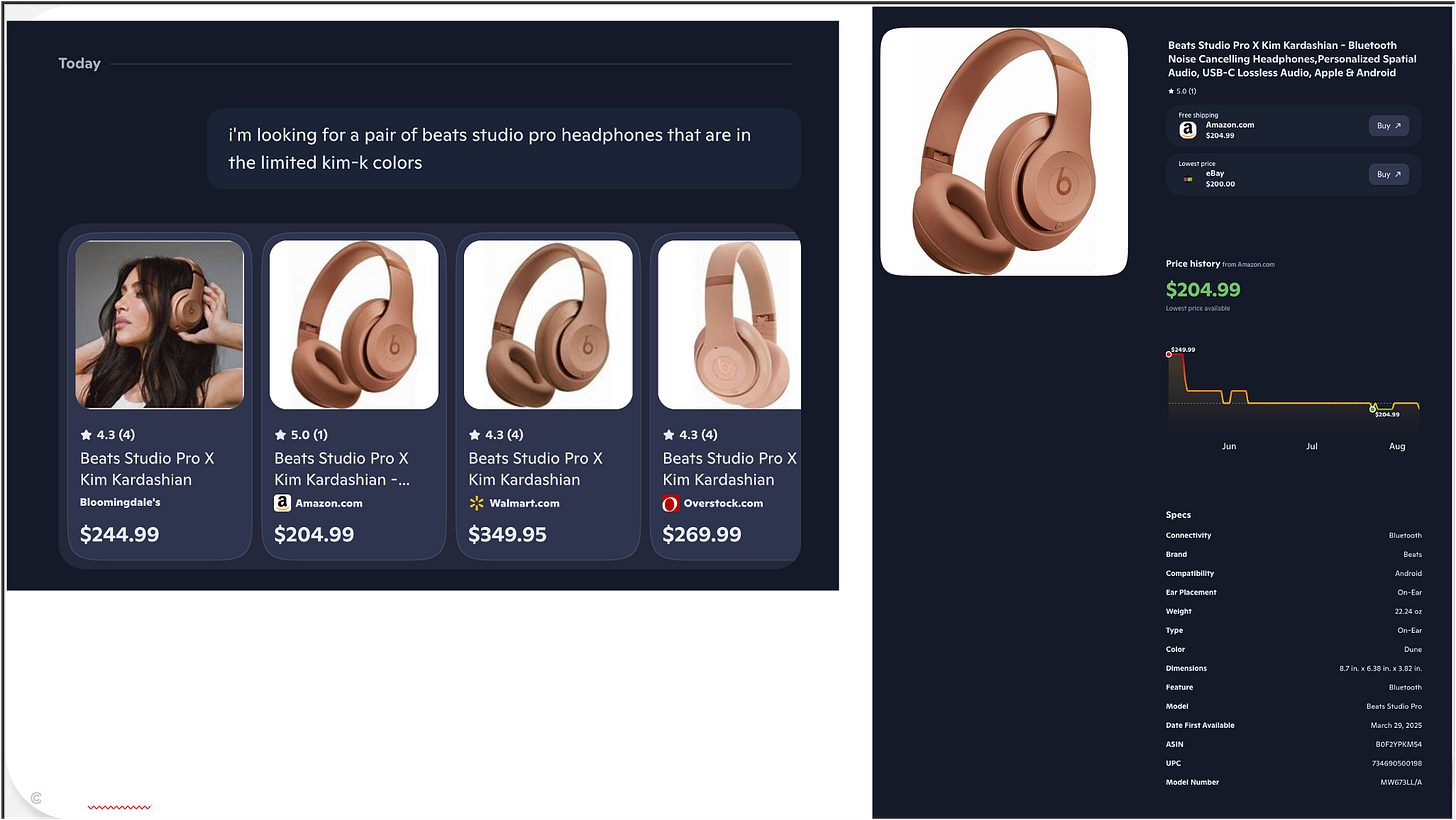Agentic Shopping News for the Week of 8/2-8/9 (week 32/52): ChatGPT-5 Drops!
Pinterest throws Agentic Shopping under the bus; Ark Invest thinks marketplaces are at Agentic risk, ChatGPT-5 launched, we have a first look at the new shopping experience.
Phew, what a week. Tuesday it started off with a bang, with OpenAI releasing new game changing open-source models. Then Sam hinted the week would have a small thing and a big thing and then BOOM - ChatGPT-5 dropped Thursday in a livestream at 1pm ET. In there Anthropic released Clause Opus 4.1 as well.
In this issue of our weekly update that is typically a light curated look at the week’s news, we're going a bit deeper and sharing a first look at the upgraded ‘product card’ experience that came out with ChatGPT-5 and changes over at Copilot. There’s also an intriguing recurring reference to ‘product search’ that could hint at future ChatPGt-5 enhancements coming.
Before we get in there, here’s some non OpenAI news items that were interesting:
Jason Goldberg: The AI Commerce Wars Have Begun
Turns out that Jason Goldberg, aka RetailGeek, is not only the Chief Commerce Strategy Officer at Publicis and World-famous celebrity podcaster, but he also is a Contributor to Forbes and this week he had a great piece out laying the background of where we’ve come so far in Agentic commerce in such a short time.
One of his points is that with this era for online shoppers….
“The journey won’t start with a click. It’ll start with a conversation — and whichever agent you trust to handle it will own your shopping future.”
Pinterest CEO Throws Agentic Shopping Under the Bus 🚌
This wasn’t surprising because one of the areas most likely to be disrupted first by Agentic Shopping is discovery. In their Q2 2025 earnings conference call, CEO ,Bill Ready, didn’t mention Ai disruption at all during the prepared remarks, but took a Q+A, I’m going to put the entire statement in here because the context of it all is relevant:
Editorial note - I’ve added paragraph numbers in parentheses so I can reference them
Analyst: Justin Patterson Question – Justin Patterson: Great. Thank you. Bill, there’s been a lot of talk about just how agentic AI is changing the search funnel. I’d love to hear you expand around just some of the investments you’re making to really succeed in this new era and how long you think it’ll be before you see some benefits there. Thank you.
(1) Answer: William J. Ready: Yeah. Thanks, Justin. First, I’d say that, as we’ve entered sort of this Cambrian moment of a lot of new AI-driven experiences and people thinking about searching in new ways, Pinterest is an AI winner in that. Through that moment, Pinterest is more popular than ever as we’re driving record highs in users, winning with the next generation, deepening engagement per user. And at the core of that is that we’ve really made AI central to everything that we’re doing.
(2) While we don’t talk about it this way, Pinterest has effectively become an AI-enabled shopping assistant. And we don’t talk about it that way, because it’s not how our users think of it. But when users say things like, Pinterest just gets me, it’s because they can open the app and the app’s going to make recommendations to them proactively on things that they’re really interested in, that align with their taste and their style, the way that a really great personal shopping assistant would.
(3) And we think there’s a lot more to go in that and that we think we have something really unique around our curation signal that doesn’t just let us understand the taste for that user individually, but when they curate and associate products, it just gives us a completely unique signal for us to show the next user that may start with just a very small signal of even just one of those products that we can then recommend what else might go with that.
(4) And not just the obvious things like you bought your first-ever bag of dog food, and so here’s a dog collar. Those are pretty obvious. But things that will say, well, if you’re into this kind of beauty product, you might be into these kinds of sort of yoga apparel or those kinds of things, and really unique associations that are going to resonate with that user.
(5) And to your question on agentic, I think this notion of an agent just going and buying all the things for you without you doing anything, I think that’s going to be a very, very long cycle for that to play out, both in terms of how the users think about it, where the users aren’t going to be ready to just let something go run off and do everything for them, save for maybe some very utilitarian journeys. But if we look at what’s happening on our platform already, we’re able to take the user much further down that shopping journey assisting them.
(6) As I mentioned with the relevance of our recommendations, that’s effectively taking the user much further down the shopping journey without them having to do the work.
(7) And so, we see really great early signs of that. And we think there’s a lot more that we’re going to be able to do there that we will focus on in a very user-centric way that meets the user where they are, but with AI and LLMs and agentic capabilities deeply embedded in the way that we’re doing that.
(8) So again, through all of that, as we’re going through this Cambrian moment, Pinterest is more popular than ever, and it’s because, again, we’ve made Pinterest into an AI winner and really made it a core competency, both based on what we’re able to do through our engineering, but importantly, the completely unique curation signal that we have on our platform. Hope that’s helpful.
I’ll start by saying Pinterest is a great platform and it will have a place in the future as long as there is a customer that enjoys that experience of visually curating products, creating inspiration boards, putting together collections and what-not. In paragraphs 1, 2 and 3, I think he’s focused on right thing - they should leverage all.
He loses me in paragraph 4. AI already has a huge advantage across several dimensions and it’s going to get further ahead. They are audience, product data and personalization.
Audience
Pinterest has about 600m MAUs. ChatGPT has 700m alone and is growing significantly faster.
Product Data
Over the years at ChannelAdvisor we worked with many eras of teams at Pinterest that were trying to tie the images that were splatted into Pinterest into shopable experiences. The results were mediocre at best. The reason why is even with visual product search and all those capabilities, most of the images on Pinterest are unmatchable to a product that can be purchased online at all. Also, many of the users don’t take the time to go through the product tagging workflow.
Agentic Shopping has billions and billions of product data and reviews from across the internet it can use for a 100% shopable experience that
Personalization
Ask your frequently used AI what it knows about you and you’ll be pretty surprised. These engines not only remember (with your permission) what you tell them, they infer a bunch of information from your prompts. This inference is what drives recommendations, like the beauty product/yoga outfit example from paragraph 4.
Agentic Shopping: 3, Pinterest: 0
Because AI has more product data, a bigger audience (more data again) and knows more about the users and products, AI has a significant advantage over Pinterest currently and it will get bigger over time.
Agentic is a very very long way off….?
Paragraph 5 is where if I think he’s 100% wrong and hopefully he comes around on this because if PInterest waits to execute for 2-3 years because they think they have a long time, that’s not going to go well. My counter argument is that Agentic is here today and works. Google has announced it at Google I/O and is adding it by Fall. OpenAI made significant improvements with ChatGPT-5 and I’m 98% confident by Holiday 2025 there is going to be a checkout or Agentic experience (or both) to round out the shopper’s journey.
Ark Invest with the Counter opinion: Agentic Commerce will eat (most) marketplaces
Counter to Bill Ready’s thoughts, the Ark Investment group has a paper out this week that analyzes the risks that e-commerce marketplaces face from Agentic and their conclusion is basically that Amazon has a shot because of FBA. That’s my take, it’s a bit academic, but I think this is the ‘kill shot’ argument for Agentic→
If I’ve learned anything about consumer behavior over the last 30 years it’s that you can never underestimate the power of a convenient, time-saving customer experience. If the out come is the same or better, a huge % of users and online wallet will gravitate to that experience. Agentic Shopping takes 2mins (that will come down) vs. 12mins for the average transaction.
I also found this diagram compelling. I think MCP is ‘too early’ it lacks some pieces that will be needed down the road, but there will be a API-like layer there after a couple more iterations. This shows how much cleaner the Agentic architecture is thanks to GenAI:
ChatGPT-5 Early Retailgentic Experiences
Instead of writing anything here that has been covered by other publications around the GPT-5 release, we’re going to focus on ChatGPT-5’s upgraded Shopping experience.
Let’s start by doing a before and after. Here’s the same prompt, same product, compared between ChatGPT-4o and ChatGPT-5 taken less than 3 weeks apart. The prompt is: “I’m looking for a pair of beats studio pro that are in the limited kim-k color”
ChatGPT-4o:
ChatGPT-5:
What’s changed in ChatGPT-5?
The underlying results are different because of the change of availability, but what you first notice is in ChatGPT-5 what we call ‘product cards’ are dramatically larger. This isn’t always consistent and in fact, our hypothesis is that in the first 48hrs they were tweaking the Shopping experience a good bit - we run many of the same prompts many times a day and during the 4o-era there was consistency in appearance and right now it’s fluctuating a good bit still.
Things seem to have settled down into what I’ll call this XL product card experience.
The second part, the ‘product offers pop-up’ is relatively similar. In ChatGPT-5, they are showing only 2-3 offers and then go to a ‘Why you might like this’ and then a ‘What people are saying’ subsection’.
What is ‘product search’?
You may have skimmed by the line above, which is new to us. In our past scan’s we’ve never seen this ‘product search’ language. If you do the next obvious step and ask what it means, you get this:
System prompts and internal tools
Inside these 2025-era models are two concepts that are good to have a working knowledge of;
System prompts - Before release each LLM is given a System Prompt - a very long prompt that tells the engine how to act, what not to say and a variety of other things. OpenAI treats them as proprietary, but if you want to see an example, Anthropic releases there’s here. This is a fascinating part of GenAI we could spend a lot of time on, think of it as a set of guidelines the model owner has given the GenAI for the user experience.
Internal Tools - One of the innovations that ChaGPT-5 brings is they have gotten rid of the model picker. Internally, the first thing that the system prompt must do is call an internal tool to pick the model. We know from API docs and some of the Youtube launch videos this internal tool is called ‘real-time router’.
What ChatGPT’s telling me in its answer is that either the system prompt or an internal tool, or a reasoning model (less likely) has told it to take my query and format it to that ‘where can I buy Beats Studio Pro Kim-K and for how much, today.”
That being said, my gut tells me there is an internal tool at play here and the system prompt is routing shopping related things to that internal tool.
No ChatGPT-5 Checkout or Shopify Integration…yet….
In the ChatGPT-4 era, new innovations on that platform came from updated ‘minor’ model releases (4 Turbo, 4p, o1, o3, etc.). It seems like thanks to this front-end real-time router internal tool, they will be making more incremental improvements to ChatGPT-5 over time vs having a 5 <minor release> type naming. Sam has said over and over that consumers are confused by the alphabet soup they ended up with.
I mention this because clearly in ChatGPT-5 we do not have the secretly previewed hosted checkout system or much rumored Shopify integration.
My prediction is that for ChatGPT-5, they felt they had to really focus on the coding use case -that occupied 60-70% of the demo time. They now have until October to get the shopping-use case solidified, and I don’t believe we’ll have to wait until ChatGPT-6, it will be coming as incremental updates to ChatGPT-5 over the next 90 days.
Copilot Shopping Improvements
Because Microsoft’s Copilot uses OpenAI as it’s LLM, but has a different UX and real-time web search capability, it’s interesting to also see the changes there. Here I did different products so you can see the difference in the kim-k
This is the ChatGPT-4o generation Copilot experience:
Here is the ChatGPT-5 generation Copilot experience:
Here the product card experience hasn’t changed much, but what I wanted to highlight is the product offers pop-up page. Note that Copilot adds a cool price trend chart and also all the attributes it knows about the product.
Conclusion
XAI, Anthropic, Google, and now ChatGPT have all released their 2025+ foundational models and Perplexity has their agentic browser, Comet, out. Over the next 90 days, I predict we’re going to see at least Google, OpenAI, Perplexity and Copilot reveal compelling Agentic Shopping improvements built on this solid new foundation in time for Holiday 2025.




